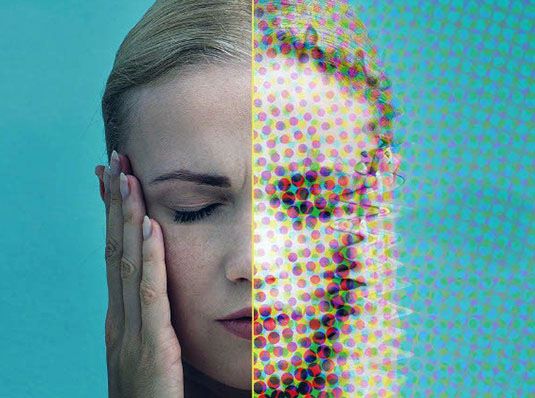Migraines

Migraines are a type of recurring headaches which cause moderate to severe pain. The pain is of a throbbing or pulsing variety, is often on one side of the head, and accompanied by other symptoms.
Signs and Symptoms:
Migraines may progress through four stages (though you may not experience all stages):
- Stage 1: Prodrome (occurs 1-2 days prior to a migraine)
- Stage 2: Aura (may or may not occur)
- Stage 3: Headache (lasts from 4-72 hours)
- Stage 4: Post-drome (lasts for about 24 hours)
Prodrome:
- Constipation
- Mood changes, from depression to euphoria
- Food cravings
- Neck stiffness
- Increased thirst and urination
- Frequent yawning
Attack:
- Pain on one side or both sides of your head
- Pain that feels throbbing or pulsing
- Sensitivity to light, sounds, and sometimes smells and touch
- Nausea and vomiting
- Blurred vision
- Lightheadedness, sometimes followed by fainting
Post-drome:
- Confusion
- Moodiness
- Dizziness
- Weakness
- Sensitivity to light and sound
Causes, Migraine Triggers, and Risk Factors:
Causes:
Though migraine causes aren't understood, genetics and environmental factors appear to play a role.
Triggers:
- Food additives: The sweetener aspartame and the preservative monosodium glutamate (MSG)
- Drinks: Alcohol, especially wine, and highly caffeinated beverages
- Stress: Stress at work or home
- Sensory stimuli: Bright lights and sun glare can induce migraines, as can loud sounds, or strong smells
- Changes in wake-sleep pattern: Missing sleep or getting too much sleep
- Physical factors: Intense physical exertion
- Changes in the environment: A change of weather or barometric pressure
- Medications: Oral contraceptives and vasodilators
- Foods: Aged cheeses, salty foods, and processed foods may trigger migraines
- Hormonal changes in women: Shortly before the onset of menstruation
Risk Factors:
Several factors make you more prone to having migraines, including:
- Family history: If you have a family member with migraines, then you have a higher risk of developing them too.
- Age: Migraines can begin at any age, though the first often occurs during adolescence, migraines tend to peak during your 30s.
- Sex: Women are three times more likely to have migraines.
Complications:
- Abdominal problems: Abdominal pain, bleeding, ulcers
- Medication-overuse headaches: Over-the-counter or prescription headache medications
- Serotonin syndrome
Treatment:
Migraine treatments can help stop symptoms and prevent future attacks. Your treatment strategy depends on the frequency and severity of your headaches, the degree of disability your headaches cause, and your other medical conditions.
- Pain-relieving medications: Also known as acute or abortive treatment, these types of drugs are taken during migraine attacks and are designed to stop symptoms. These are as follows:
- Pain relievers: Aspirin or ibuprofen (Advil, Motrin IB, others) may help relieve mild migraines.
- Triptans: These medications are often used in treating migraines. Triptans make blood vessels constrict and block pain pathways in the brain.
- Ergots: Ergotamine and caffeine combination drugs (Migergot, Cafergot) are less effective than triptans. Ergots seem most effective in those whose pain lasts for more than 48 hours.
- Anti-nausea medications: Medication for nausea is usually combined with other medications. Frequently prescribed medications are chlorpromazine, metoclopramide (Reglan), or prochlorperazine (Compro).
- Opioid medications: Opioid medications containing narcotics, particularly codeine, are sometimes used to treat migraine pain for people who can't take triptans or ergots.
- Glucocorticoids (prednisone, dexamethasone): A glucocorticoid may be used with other medications to improve pain relief.
- Preventive medications: These types of drugs are taken regularly, often on a daily basis, to reduce the severity, the frequency, and length of migraines and may increase the effectiveness of symptom-relieving medicines used during migraine attacks.
- Cardiovascular drugs: Beta blockers, which are commonly used to treat high blood pressure and coronary artery disease, may reduce the frequency and severity of migraines.
- Antidepressants: Tricyclic antidepressants may be effective in preventing migraines, even in people without depression.
- Anti-seizure drugs: Some anti-seizure drugs, such as valproate (Depacon) and topiramate (Topamax), seem to reduce the frequency of migraines.
- OnabotulinumtoxinA (Botox): OnabotulinumtoxinA.
- Erenumab-aooe (Aimovig): Is a new class of injectable.
References:
CIS does not provide medical advice, diagnosis or treatment. The content provided is for informational purposes only.
Back To Health Education